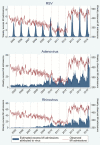Laboratory-Confirmed Respiratory Infections as Predictors of Hospital Admission for Myocardial Infarction and Stroke: Time-Series Analysis of English Data for 2004-2015
- PMID: 29324996
- PMCID: PMC6005111
- DOI: 10.1093/cid/cix1144
Laboratory-Confirmed Respiratory Infections as Predictors of Hospital Admission for Myocardial Infarction and Stroke: Time-Series Analysis of English Data for 2004-2015
Abstract
Background: Acute respiratory infections are associated with increased risk of myocardial infarction (MI) and stroke; however, the role of different organisms is poorly characterized.
Methods: Time-series analysis of English hospital admissions for MI and stroke (age-stratified: 45-64, 65-74, ≥75 years), laboratory-confirmed viral respiratory infections, and environmental data for 2004-2015. Weekly counts of admissions were modeled using multivariable Poisson regression with weekly counts of respiratory viruses (influenza, parainfluenza, rhinovirus, respiratory syncytial virus [RSV], adenovirus, or human metapneumovirus [HMPV]) investigated as predictors. We controlled for seasonality, long-term trends, and environmental factors.
Results: Weekly hospital admissions in adults aged ≥45 years averaged 1347 (interquartile range [IQR], 1217-1541) for MI and 1175 (IQR, 1023-1395) for stroke. Respiratory infections ranged from 11 cases per week (IQR, 5-53) for influenza to 55 (IQR, 7-127) for rhinovirus. In the adjusted models, all viruses except parainfluenza were significantly associated with MI and ischemic stroke admissions in those aged ≥75. Among 65- to 74-year-olds, adenovirus, rhinovirus, and RSV were associated with MI but not ischemic stroke admissions. Respiratory infections were not associated with MI or ischemic stroke in people aged 45-64 years, nor with hemorrhagic stroke in any age group. An estimated 0.4%-5.7% of MI and ischemic stroke admissions may be attributable to respiratory infection.
Conclusions: We identified small but strongly significant associations in the timing of respiratory infection (with HMPV, RSV, influenza, rhinovirus, and adenovirus) and MI or ischemic stroke hospitalizations in the elderly.
Clinical trials registration: NCT02984280.
Figures






Comment in
-
Respiratory Infections as Predictors of Hospital Admission for Myocardial Infarction and Stroke: Pathophysiologic and Therapeutic Considerations.Clin Infect Dis. 2019 Jan 18;68(3):533. doi: 10.1093/cid/ciy685. Clin Infect Dis. 2019. PMID: 30304438 No abstract available.
References
-
- Levi F, Chatenoud L, Bertuccio P, Lucchini F, Negri E, La Vecchia C. Mortality from cardiovascular and cerebrovascular diseases in Europe and other areas of the world: an update. Eur J Cardiovasc Prev Rehabil 2009; 16:333–50. - PubMed
-
- Smeeth L, Thomas SL, Hall AJ, Hubbard R, Farrington P, Vallance P. Risk of myocardial infarction and stroke after acute infection or vaccination. N Engl J Med 2004; 351:2611–8. - PubMed
-
- Clayton TC, Thompson M, Meade TW. Recent respiratory infection and risk of cardiovascular disease: case-control study through a general practice database. Eur Heart J 2008; 29:96–103. - PubMed
Publication types
MeSH terms
Associated data
Grants and funding
LinkOut - more resources
Full Text Sources
Other Literature Sources
Medical

